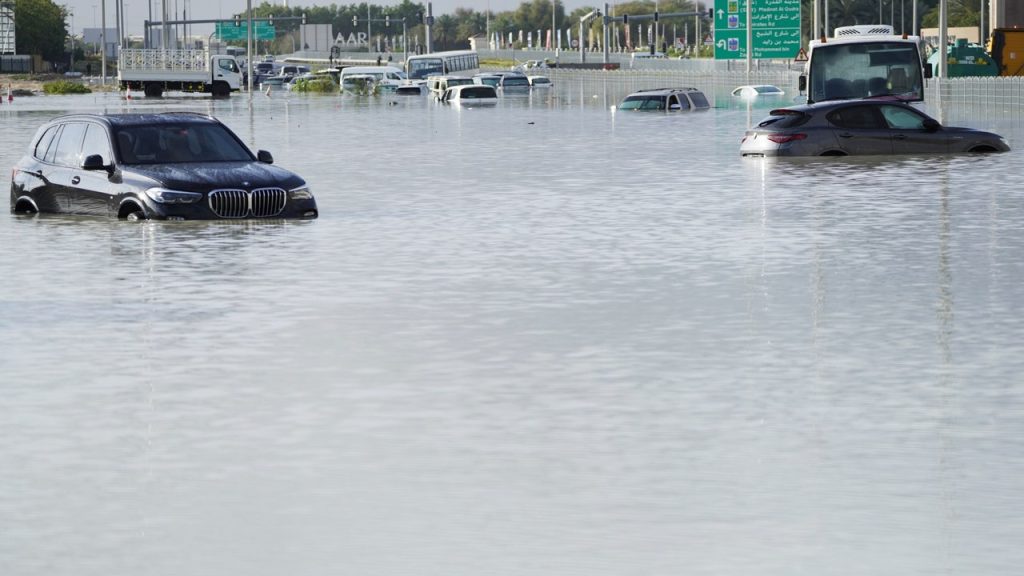Dubai experienced the heaviest rain ever recorded in the UAE on Tuesday, causing widespread flooding that disrupted flights at Dubai International Airport, the world’s busiest airport for international travel. This historic weather event surpassed anything documented in the country since data collection began in 1949. While rain also fell in other nearby countries, including Bahrain, Oman, Qatar, and Saudi Arabia, the UAE was the hardest hit. The storm sparked speculation about cloud seeding, a technique used to induce rain artificially, but experts dismissed this theory, attributing the deluge to a strong low pressure system and intense thunderstorms. Climate change is also a likely factor in the increased frequency of extreme weather events in the region.
The rain started on Monday night and intensified throughout Tuesday, leading to over 142 millimeters of rainfall in Dubai, significantly surpassing the average annual rainfall of 94.7 millimeters. Roads, deserts, and the airport all faced significant flooding, with taxiways submerged and flights disrupted. Passengers struggled to reach terminals and flights were affected. The situation at the airport worsened when check-in services were halted, leaving many stranded and unable to travel. Schools across the UAE closed ahead of the storm, while government employees worked remotely. Water pumps and tanker trucks were deployed to clear the flooding on the streets and highways. Unfortunately, some individuals lost their lives due to the intense weather conditions.
The heavy rains also impacted neighboring Oman, where at least 19 people were killed as a result of the flooding. Among the casualties were 10 schoolchildren who were swept away in a vehicle during the heavy downpours. The tragic incident prompted condolences from leaders across the region. In response to the extreme weather, the country’s National Committee for Emergency Management issued a statement highlighting the devastation caused by the heavy rains. Schools and government offices were closed, and residents were urged to exercise caution and stay safe during the adverse weather conditions.
The UAE conducts cloud seeding operations to increase its water supply through desalination plants. However, the National Center for Meteorology clarified that no cloud seeding took place on the day of the heaviest rainfall. The cloud seeding flights were conducted in advance of the storm systems that led to the record-breaking rain. Experts emphasized that the intense storms and flooding were a result of an unusually strong low pressure system, rather than artificial rain induction. Climate change, which has been linked to more extreme weather events globally, is also a contributing factor to the increased intensity of storms, droughts, and floods in the region.
Dubai International Airport faced significant challenges as passengers were stranded and flights were impacted by the flooding. The airport CEO acknowledged the difficulties posed by the weather conditions, describing the situation as unprecedented and challenging. Flights were diverted to alternate airports, and efforts were made to clear the airport of transit passengers. The disruptions extended to other airlines like FlyDubai and EgyptAir, which also suspended flights to and from Dubai due to the bad weather conditions. The closure of schools and remote work arrangements for government employees were implemented to ensure the safety of residents during the extreme weather event.
Authorities in the UAE and Oman responded to the heavy rains with emergency measures, including the deployment of water pumps, tanker trucks, and closures of schools and government offices. In light of the devastating impact of the flooding, precautions were taken to mitigate further risks to residents and travelers in the affected areas. The extreme weather conditions underscore the vulnerability of the region to climate-related disasters and the urgent need for adaptation strategies to address the growing risks posed by climate change. Efforts to improve infrastructure, drainage systems, and disaster preparedness are essential to safeguard public safety and mitigate the impact of future extreme weather events.


